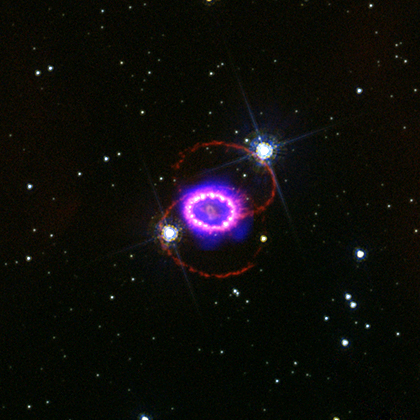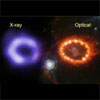Twenty Years Since a Spectacular Explosion

Credit: X-ray: NASA/CXC/PSU/S.Park & D.Burrows.; Optical: NASA/STScI/CfA/P.Challis
February 24, 2007 marks the 20th anniversary of one of the most spectacular events observed by astronomers in modern times, Supernova 1987A. The destruction of a massive star in the Large Magellanic Cloud, a nearby galaxy, spawned detailed observations by many different telescopes, including NASA's Chandra X-ray Observatory and Hubble Space Telescope. The outburst was visible to the naked eye, and is the brightest known supernova in almost 400 years.
This composite image shows the effects of a powerful shock wave moving away from the explosion. Bright spots of X-ray and optical emission arise where the shock collides with structures in the surrounding gas. These structures were carved out by the wind from the destroyed star. Hot-spots in the Hubble image (pink-white) now encircle Supernova 1987A like a necklace of incandescent diamonds. The Chandra data (blue-purple) reveals multimillion-degree gas at the location of the optical hot-spots. These data give valuable insight into the behavior of the doomed star in the years before it exploded.
|
||||||||||||||||||||||||||||||
Supernova 1987A was discovered on February 24, 1987, and is one of the brightest and most well-studied supernovae in recent history. The image shows a very large-field X-ray and optical view of Supernova 1987A, which appears as a small but bright blue-purple circular object in the center of the image with a pink-white rim. A larger figure 8-shape in red extends around the inner circle and is seemingly intercepted by 2 bright white foreground stars at 1 o'clock and 8 o'clock. This composite image shows the effects of a powerful shock wave moving away from the explosion. The bright spots of X-ray and optical emission arise where the shock collides with structures in the surrounding gas. These structures were carved out by the wind from the destroyed star. Hot-spots in the Hubble image (pink-white) now encircle Supernova 1987A like a necklace of incandescent diamonds. The Chandra data (blue-purple) reveals multimillion-degree gas at the location of the optical hot-spots. These data give valuable insight into the behavior of the doomed star in the years before it exploded.




